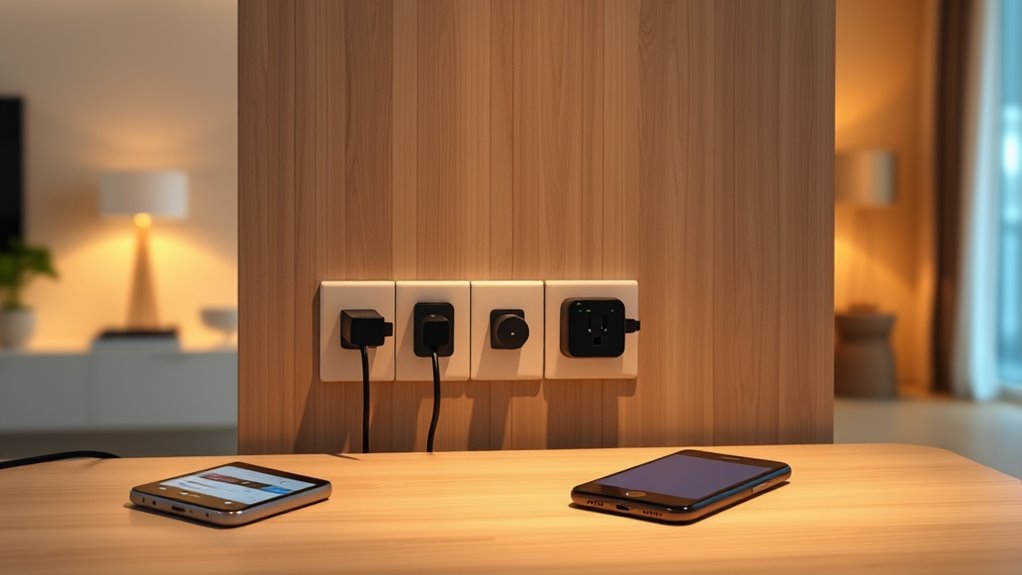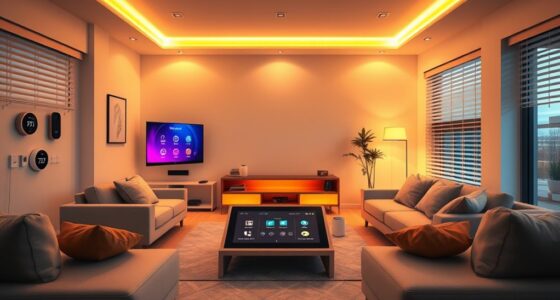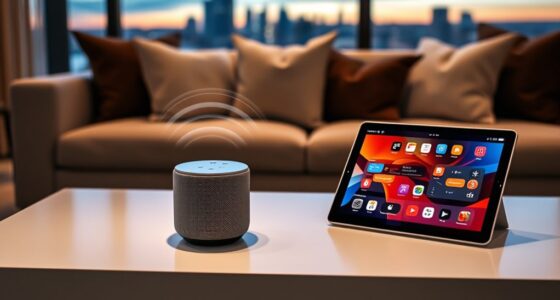Smart plugs are affordable devices that let you control your appliances remotely, helping you save energy and boost safety without spending much. They connect to your Wi-Fi and work with voice assistants, making automation simple and convenient. You can set schedules, monitor power use, and prevent accidents easily. If you’re curious about how to make your home smarter on a budget, there’s plenty more to discover on how these devices can fit your needs.
Key Takeaways
- Smart plugs enable remote control and automation of appliances, reducing energy use without significant upfront costs.
- They help save money by eliminating standby power and enabling scheduling to turn off devices when unused.
- Compatible with voice assistants like Alexa or Google Home, making automation simple and hands-free.
- Many affordable options start around $15, offering essential features for energy savings and convenience.
- Choosing models with safety features like surge protection and reliable connectivity ensures safe, efficient automation.
What Are Smart Plugs and How Do They Work

Smart plugs are devices that fit between your wall outlet and an electrical appliance, allowing you to control the power supply remotely. They act as a switch, turning appliances on or off through your smartphone, voice commands, or automation setups. Fundamentally, they convert traditional “dumb” devices into smart ones that can be integrated into your home automation system. Designed to be compact, smart plugs don’t block adjacent outlets or power strips. They connect to your home network via Wi-Fi, Bluetooth, Zigbee, or Z-Wave, enabling control from anywhere. Many models are compatible with voice assistants like Alexa or Google Home, offering hands-free operation. Once connected, you can easily monitor and manage your appliances remotely, making your home smarter without rewiring or replacing existing devices. Understanding the contrast ratio of connected devices can help optimize your home theater setup for better image quality.
Saving Energy and Money With Smart Plugs
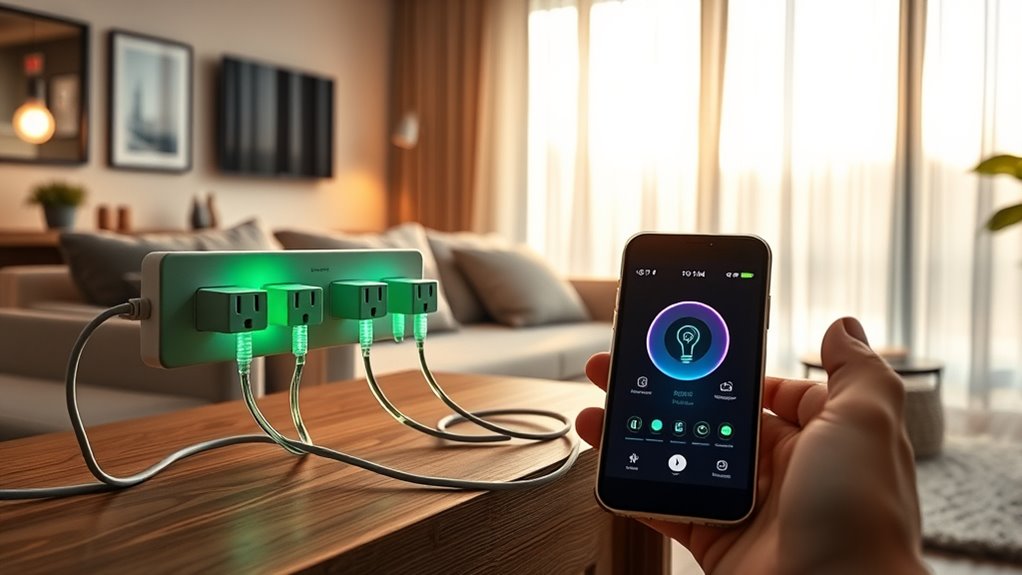
Using smart plugs can substantially reduce your household energy bills by cutting down on unnecessary power consumption. They eliminate standby power, which accounts for 5-10% of energy use, and target “energy vampires” like TVs and computers that draw power even when off—reducing this by 80-90%. Automating device schedules ensures appliances turn off when not needed, saving energy. Plus, real-time energy monitoring helps you identify waste and make smarter choices. The table below highlights key savings: Understanding city dynamics can help in optimizing how you manage your energy use at home.
| Benefit | Impact |
|---|---|
| Reduced standby power | Up to 10% household savings |
| Energy vampire reduction | 80-90% less power consumption |
| Automated scheduling | Less waste, lower bills |
| Real-time monitoring | Informed energy decisions |
| Cost-effective investment | Payback in less than two years |
Smart plugs are an affordable way to cut costs and support sustainable living. In addition, smart plugs can be integrated into broader home automation systems, enhancing overall energy management and allowing for more comprehensive control over household energy use.
Making Life Easier: Automation and Convenience Features

Automation and convenience features in smart plugs make managing your household devices simple and effortless. With your smartphone, you can control appliances from anywhere with an internet connection, turning them on or off instantly. Scheduling functions let you set devices to operate automatically, like having lights turn on at sunset or your coffee brew at a specific time, without manual effort. Many smart plugs also work offline through standards like Matter, ensuring continuous operation even if your internet goes down. Smart plugs can also monitor energy consumption, helping you track and reduce your electricity usage. Compatibility with voice assistants like Alexa or Google Assistant allows hands-free control, making daily routines easier. You can create custom scenes that activate multiple devices at once or integrate them into broader automation systems for seamless home management. Setup is straightforward, and universal designs fit standard outlets, making automation accessible and practical for everyone. Additionally, some smart plugs are designed to support electric power generation, providing alternative energy solutions for your home.
Safety Benefits of Using Smart Plugs
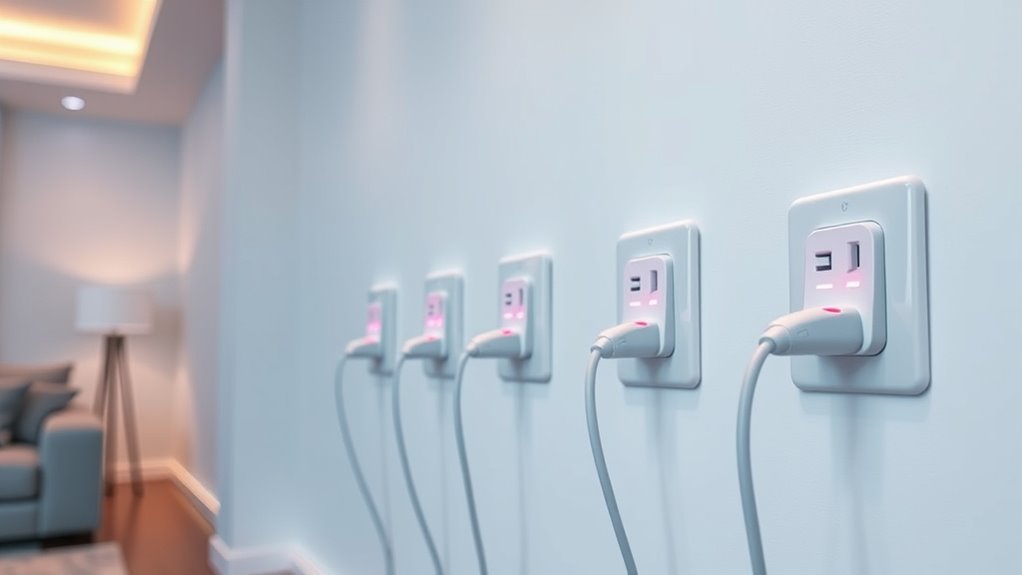
Enhancing convenience with smart plugs also brings important safety benefits that help protect your home and belongings. Many smart plugs feature built-in surge protection, shielding your devices from voltage spikes. Overload prevention automatically cuts power if the load gets too high, reducing fire risks. Thermal protection shuts off the plug when overheating is detected, preventing potential hazards. Using certified, authentic smart plugs ensures these safety features work properly, unlike counterfeit versions that lack protections and pose safety risks. Remote monitoring and control allow you to turn off appliances from anywhere, preventing accidents caused by forgotten devices like space heaters or irons. Real-time status updates and scheduled shutdowns further minimize fire hazards. Proper installation and regular safety checks ensure these devices continue to operate safely and effectively. Incorporating safety features such as automatic shutoff and surge protection can significantly reduce electrical dangers. Overall, smart plugs serve as proactive tools to keep your home safer and reduce electrical danger.
Choosing Compatibility and Affordability for Your Smart Home

Choosing the right smart plug for your home depends on balancing compatibility with your existing devices and your budget. Most smart plugs use Wi-Fi for control, but emerging standards like Matter aim to unify communication across brands, improving cross-device integration. Bluetooth is mainly for setup and offers limited range, so prioritize Wi-Fi or Thread-enabled plugs for reliability. Compatibility with voice assistants like Alexa, Google Assistant, or Apple HomeKit varies by brand, affecting your smart home ecosystem. Affordable options typically cost around $15, but cheaper models may lack advanced features like energy monitoring or broad voice support. Consider design elements like size, manual controls, and durability to suit your needs. Balancing these factors guarantees your smart plug offers seamless integration without overspending. Furthermore, understanding the underlying technology can help you make better choices for future-proofing your setup, ensuring your investment remains relevant as smart home standards evolve.
Frequently Asked Questions
Can Smart Plugs Work Without Wi-Fi or Internet Access?
You wonder if smart plugs can work without Wi-Fi or internet. Generally, most rely on Wi-Fi to function remotely or access cloud features, so they won’t work offline. However, if you choose Zigbee or Z-Wave plugs paired with a local hub, you can control them without internet, using local automation. Just make sure your device supports local control and set up a compatible hub for reliable offline operation.
How Secure Are Smart Plugs Against Hacking or Unauthorized Access?
Oh, sure, your smart plug is a fortress—until hackers decide it’s a tempting snack. In reality, smart plugs face significant security risks, with vulnerabilities like weak passwords and outdated firmware making them easy targets. Attackers can exploit these flaws to gain unauthorized access, disrupt your devices, or even hijack your network. To stay safe, regularly update firmware, use strong passwords, and disable unused services—because your smart plug’s security is only as good as your last update.
Are Smart Plugs Suitable for Outdoor or Weather-Resistant Use?
You’re wondering if smart plugs are suitable for outdoor use. Many outdoor smart plugs are weather-resistant, with IP ratings like IP64, IP65, or IP66, offering protection against dust and water. They’re designed for outdoor conditions, supporting features like temperature resistance and weatherproof covers. Just make certain you choose a model with the right IP rating and keep sockets covered when not in use, so they last and function properly outside.
Do Smart Plugs Support Energy Monitoring in Real-Time?
You asked if smart plugs support real-time energy monitoring. Yes, many models do, like Kasa KP115 and TP-Link HS110, providing live power consumption data through their apps. You can see instantaneous wattage and track usage over time, helping you identify high-energy devices and save. With this feature, you can automate or control your devices more efficiently, making your home smarter and more energy-conscious.
Can I Use Smart Plugs With Non-Smart or Legacy Appliances?
You can use smart plugs with non-smart or legacy appliances, but keep in mind they mainly control power on/off. Since older appliances lack communication features, the smart plug can’t offer advanced automation or status updates. Make sure the plug’s power rating matches your appliance’s needs to avoid damage. While you can control these devices remotely, full automation and energy monitoring are limited, relying mainly on simple on/off switching.
Conclusion
Smart plugs make home automation simple and affordable, helping you save energy and add convenience. Did you know that using smart plugs can reduce energy consumption by up to 12%? That’s a smart way to cut costs and lessen your environmental impact. Whether for safety, convenience, or savings, these devices are a practical step toward a smarter home. Embrace automation today and enjoy the benefits without breaking the bank.
